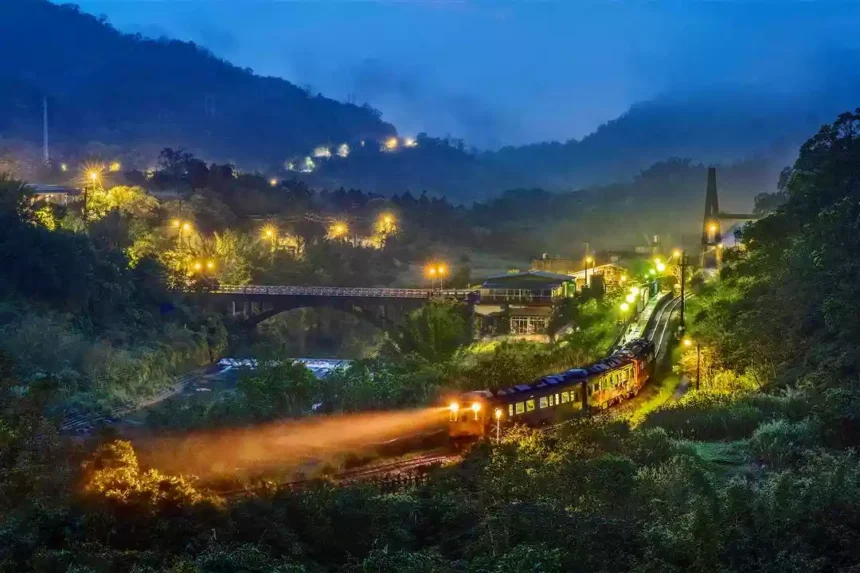A Journey Like No Other
On Taiwan’s eastern seaboard, where sheer cliffs drop dramatically into the Pacific Ocean and lush mountains rise like green waves, lies one of the most spectacular railway journeys in the world. Winding its way through 50 tunnels and crossing 77 bridges, this epic route offers not just transportation but an unforgettable experience of nature, engineering, and culture. The railway, which connects the northern city of Taipei to the southern tip at Taitung, embodies Taiwan’s determination to carve passage through formidable landscapes without compromising their stunning beauty.
This route, particularly the segment stretching from Hualien to Taitung, has earned a legendary status among train enthusiasts and travelers alike. It is not just a railway—it’s a moving window into the geographical and cultural heart of Taiwan.
The Engineering Marvel of Taiwan’s East Coast Line
Constructing a railway line through one of the most seismically active and topographically challenging regions in Asia was never going to be easy. The eastern corridor of Taiwan is characterized by rugged terrain, narrow coastlines, and steep mountain ranges that plunge into the sea. In such a setting, straight tracks are a luxury. Instead, the engineers of Taiwan’s Eastern Line had to drill, dig, and raise a path—hence the need for 50 tunnels and 77 bridges.
One of the most impressive structures along the route is the Xikou Suspension Bridge, which spans a deep valley and offers an aerial view of the forested ravine below. Equally dramatic are the tunnels—especially the ones that curve through the mountains in darkness, only to spit the train out into sudden, blinding daylight, revealing dramatic seascapes or verdant rice paddies.
The project required decades of planning, dating back to the Japanese colonial era in the early 20th century. But modern upgrades in recent years have transformed it from a slow, creaky path into a sleek, efficient line that still retains its scenic charm.
A Train Ride Through Taiwan’s Wild East
The journey truly begins in Hualien, a city nestled between the Central Mountain Range and the Pacific Ocean. As the train pulls out, passengers are treated to immediate views of rice fields and distant peaks. Slowly, the urban sprawl gives way to dramatic coastline, where waves crash against rocky shores and fishing villages dot the landscape.
Then come the tunnels—one after another, cutting through ancient rock formations and under forest-covered slopes. Some are short, blinking past in seconds. Others are long and serpentine, plunging riders into darkness before emerging into yet another stunning vista.
Bridges, too, make their mark. Spanning gorges and rivers, these engineering wonders offer a moment of light and air after the dark tunnels. The contrast is striking—and it’s part of what makes the journey so engaging. One moment you’re in a subterranean cocoon, the next you’re suspended above a turquoise river or skimming the edge of a cliff.
The most dramatic section is between Yuli and Taitung, where the railway hugs the coastline and climbs through forested valleys, delivering one jaw-dropping view after another. There are spots where the train seems to fly above the sea, the tracks laid so close to the edge that it feels as if the Pacific is reaching up to greet you.
Cultural Encounters Along the Way
What sets this train journey apart is not just the natural beauty, but the human stories that accompany it. Along the route, travelers pass through towns and villages inhabited by Taiwan’s indigenous communities—particularly the Amis, Bunun, and Truku peoples.
At stops like Yuli and Guangfu, passengers can disembark to explore local markets, where traditional foods, crafts, and music create a rich cultural tapestry. Some communities even stage performances or festivals timed with the arrival of trains, welcoming tourists as guests rather than just passersby.
In these regions, the train is more than a mode of transport—it is a lifeline. It connects remote communities to urban centers, enables trade, and allows for education and healthcare access. The railway is both a symbol of progress and a conduit for preserving local culture.
A Ride for the Senses
What truly makes this train journey “epic” is how it engages all the senses. The visual drama is obvious, but there’s more. The rhythmic clatter of the train, the rush of wind as you pass through a tunnel, the scent of salt and pine as you roll by the coast—it all combines to create a deeply immersive experience.
Many travelers prefer to ride in observation cars or lean out of open windows (where safe and permitted) to feel the full presence of the landscape. Photographers, in particular, are drawn to this journey for its changing light and jaw-dropping compositions.
Seasonal shifts also add depth to the journey. In spring, cherry blossoms bloom along the tracks in mountain regions. Summer brings lush green rice fields and intense blue skies. Autumn offers golden harvests, while winter casts a misty, mysterious aura over the peaks.










